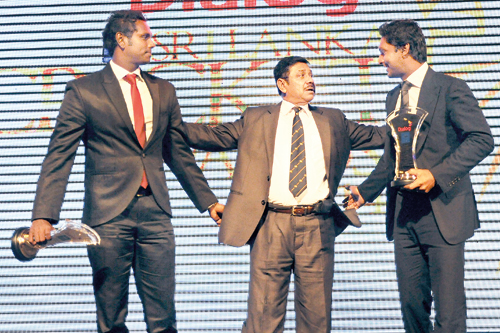Cricket of today: Are we belly up?
View(s):
Former national captain Bandula Warnapura (centre) was lamenting cricket’s status quo
I was truly mesmerised. It’s the real, true story of survival. English naturalist Sir David Attenborough and BBC filmmakers recorded the unique behaviour of a cave-dwelling fish in the arid South of Madagascar. While living in total darkness, this little fish not only lost its pigment, but its eyes too. But, the most intriguing fact is that, they swim belly-up always. May be that is nature’s way of balancing that species’ survival, but, it is said that these little fish have survived in that sunless cave over a millennia.
We, on this little island, too, are struggling – swimming belly-up. At this juncture, the Sunday Musings is only interested in how we are to swim ashore with our little cricket predicament, especially, under a political tongued Sports Minister like Faiszer Musthapha, who apparently does know the art of preserving the cricket that is left in us.
Cricket is a game that has survived in this island for more than 200 years. The game grew under its own rules, rather than a structured plan like in Old Blighty. Like I have explained a few times before, the game of cricket grew hand in hand with the schools’ structure. Yes, there may have been cricket in the upper echelons of only white, prior to that among the English soldiers. Cricket in a real sense of Lankan style came with the game homing in with the Royal-Thomian and other school cricket encounters that captured our imagination. It is difficult to define who made the real bondage between school cricket and the club system, but both grew in tandem into almost one entity; feeding off the fat of the other.
A little after the first century, cricket in Sri Lanka had formed its real structure. Then the schools had structured itself into several age groups. Starting with Under (U)-14, U-16 and U-19 or the 1st XI. At the same time, all top schools that played cricket had their own coaching system and at the end of their natural school career, the very top grade of cricketers were taken into the division three side of a club which in turn had its own structured system.
For instance, when a cricketer leaves Royal College, the young lad would join the SSC’s Daily News Trophy pool. In this pool, there were about 4-6 veteran cricketers who had travelled past the national crest but, still involved with the game just for the love of it. There they played a vital role. In turn, these veterans would churn in their own skills to the school leaving youngsters, thus turning them into tempered hard nuts in cricket. After a season or two, the young ones would graduate to the 2nd division, while knocking the doors of the top division. Then, when one goes out of form in the top division, the cricketer has the opportunity of sliding down to the lower division and launch the recuperation of his career.
More than 50 years ago, Sri Lanka had a cricket structure that worked. There was a system that worked from U-14 to the top level, where they picked the national team; the lineage was unbroken. The cricketers were systematically being groomed for the next stage, like in a pipeline. There was no necessity for Max Academies or cricket graduation centres; the talent was groomed within. Well, Nalandian Roshan Mahanama, through that system, played Division III cricket while he was only 14, while Arjuna Ranatunga played in the inaugural Test match in 1982 while still a 17-year-old schoolboy at Ananda College. Kumar Sangakkara was not the same champion cricketer while at Trinity College Kandy, but his graduation through the pipeline converted him into the legend he grew to be.
Now the school cricket system is trying to put on some diapers to stop its purging, and the Education Minister has rounded up a group of experts to effect systems, but I say the execution of that redemption is still done by the same group of people who, initially, set in the rot. So, can we expect a good interpretation to the new recommendations?
Then the club system is ruined by making it a political qualification. The result, there are 24 Division I clubs in the system, when the real requirement is only around 10-12 teams — teams that could make a real change in the cricketing standards of Lankan cricket.
These are some of the fundamental issues affecting our cricket that need immediate attention.
On Thursday, during the Dr Upali Mahanama Memorial lecture, its main speaker, former national captain Bandula Warnapura was lamenting about cricket’s status quo. He was defining the past, present and the future of Sri Lanka cricket — some things in almost the same lines that we were penning our thoughts, too, in this edition’s of Sunday Musings.
There he defined the past and how the custodians of the game nurtured it in the last millennia. Then he explained how the rot set in with the politicking taking pride of place over the real issues pertaining to the wellbeing of the game.
 Talking of the future of the game, Warnapura says he did not have enough substance to sustain the castle, but was confident that Lankans do possess the talent to survive. He said things to the effect that our cricket also would lose its pigment and eyes and begin to swim belly-up, if remedial measures are not affected immediately.
Talking of the future of the game, Warnapura says he did not have enough substance to sustain the castle, but was confident that Lankans do possess the talent to survive. He said things to the effect that our cricket also would lose its pigment and eyes and begin to swim belly-up, if remedial measures are not affected immediately.
He said Lankan cricket needs forensic surgery like changing the constitution, bringing the number of votes to around 20-30 and more importantly, pave the way for the cricket-oriented governing body to take over. Earnestly, he said, there are cricketers like him in the forum, who are looking for the opportunity to take over and put cricket back on its feet again.
Then he said the present sports minister holds the key to the issue, and added: In the past there were sports ministers like K.B. Ratnayake, V.A. Sugathadasa and Vincent Perera who understood the importance of sports and acted with a lot of conviction.
Warnapura said the necessary changes to the structure of cricket could only be done through an act of Parliament. If the minister could only take that bold stance and effect the changes, he will definitely be written in the annals of cricket, as the man who paved the way to save the day for our cricket.
As for me, if he cannot do it, God help Sri Lanka’s cricket.


